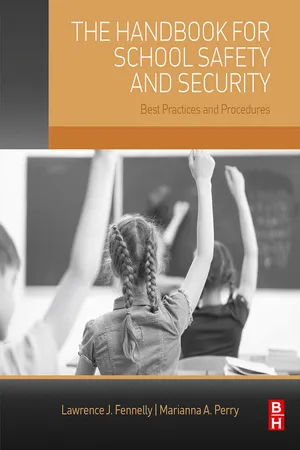
The Handbook for School Safety and Security
Best Practices and Procedures
- 420 pages
- English
- ePUB (mobile friendly)
- Available on iOS & Android
The Handbook for School Safety and Security
Best Practices and Procedures
About this book
School security is one of the most pressing public concerns today. Yet in most schools, there is little security expertise or detailed knowledge about how to implement and manage a security program. The Handbook for School Safety and Security rectifies this problem by providing the salient information school administrators and security professionals need to address the most important security issues schools face.Made up of contributions from leading experts in school security, The Handbook for School Safety and Security provides a wealth of practical information for securing any K-12 school. It discusses key approaches and best practices for school crime prevention, including such topics as crisis management and mass notification. It also covers the physical measure needed for protecting a school, including detailed discussions of access control, lighting, alarms, and locks.While there is no single fix for the myriad of security challenges facing today's school security professionals, the best practices found in The Handbook for School Safety and Security will help increase the safety and security of any school.- Brings together the collective experience of industry-leading subject matter specialists into one resource.- Covers all the key areas needed for developing and implementing a school security program.- Includes a list of 100 things to know when developing a school security program.
Frequently asked questions
- Essential is ideal for learners and professionals who enjoy exploring a wide range of subjects. Access the Essential Library with 800,000+ trusted titles and best-sellers across business, personal growth, and the humanities. Includes unlimited reading time and Standard Read Aloud voice.
- Complete: Perfect for advanced learners and researchers needing full, unrestricted access. Unlock 1.4M+ books across hundreds of subjects, including academic and specialized titles. The Complete Plan also includes advanced features like Premium Read Aloud and Research Assistant.
Please note we cannot support devices running on iOS 13 and Android 7 or earlier. Learn more about using the app.
Information
Best Practices—A Sixteen-Point Master Plan
Abstract
Introduction
Part A. Administrative Procedures
Part B. Physical Security (See Part II)
Table of contents
- Cover image
- Title page
- Table of Contents
- Copyright
- Dedication
- Book Opening Quote
- Foreword
- Preface
- About the Editors and Contributors
- Part 1: Approaches and Best Practices for School Crime Prevention
- Part 2: Approaches to Physical Security
- Part 3: Approaches to Operational Issues, Specific Threats, and Solutions
- Appendix: ASIS International’s List of School Security Websites Associations, Organizations, Publications
- Additional Resources
- Index